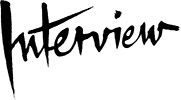
- Source: Interview Magazine
- Author: Matt Mullen
- Date: June 02, 2016
- Format: DIGITAL
Terence Koh Brings Bees Downtown
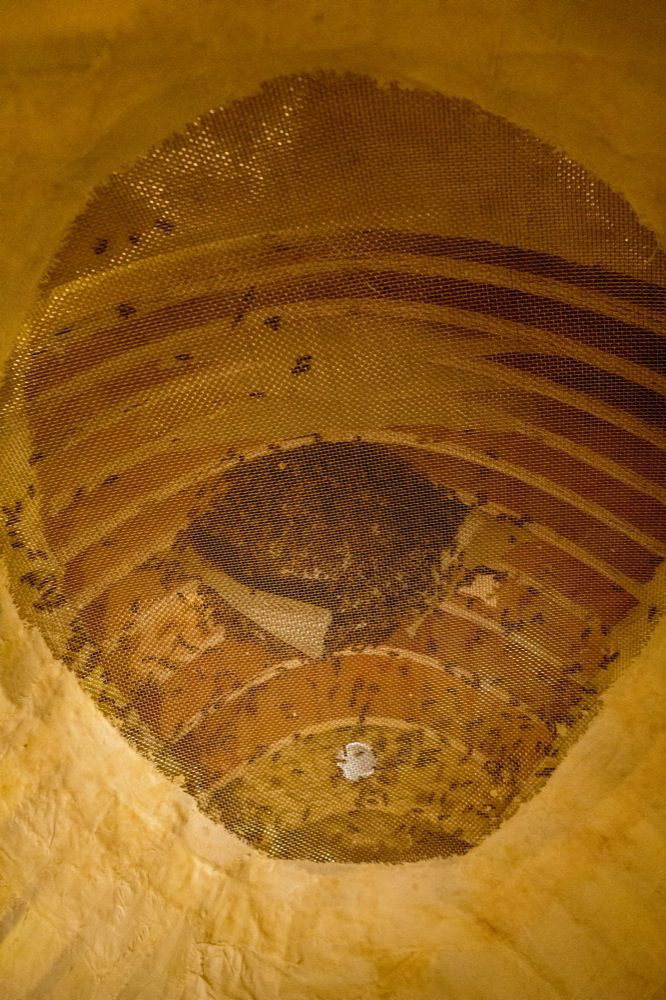
"terence koh: bee chapel," 2016. Installation image courtesy of the artist and Andrew Edlin Gallery. Photo: Olya Vysotskaya
The image of Terence Koh hauling rocks and planting trees on a mountain in the Catskills may come as a surprise to those who last saw him in his 2011 show at Mary Boone Gallery, “nothingtodoo.” In that, Koh, wearing all white, slowly crawled around a towering circle of salt, for eight hours a day, for four weeks. Roberta Smith, in The New York Times, speculated the performance might be “an extended apology for past bad-boy behavior.” By then, the Chinese-born, Canadian-raised artist had made a name for himself as an art world provocateur: equal parts irreverent and inscrutable. His art, which began with zines, morphed into paintings, sculptures, installations, and performances, including—famously—his own excrement covered in gold-leaf, which he sold for half a million dollars. Outside the gallery, Koh liked to party, and could often be found at gatherings downtown, and like his performance, always dressed in white.
Then, some two-and-a-half years ago, Koh switched to denim overalls and moved to upstate New York to become closer to nature. He insists it was no retirement, but rather the beginning of a new chapter of his career, the results of which are now on view at Andrew Edlin Gallery. Titled “bee chapel,” the exhibition is Koh’s first since 2014 and opened late last month at the gallery’s new space on Bowery. The heart of the show is the titular bee chapel, an oversized hive made of wood and canvas that houses 20,000 bees. An apple tree, suspended between life and death, has been transplanted into another room, while the artist’s beeswax collages, adorned with political pins, hang elsewhere in the gallery. Koh also experimented with sound: a recent recording of black holes colliding plays in one room, and the buzzing bees, which are mic’ed, can be heard in another. Simultaneously, the sounds are being transmitted back into outer space via an antenna on the street outside.
We recently visited the gallery and spoke to Koh, first inside the bee chapel (a tiny, womblike space in which the bees could be observed through wire mesh), later moving to the “campfire room,” a separate space in the gallery. Here, the floor was dirt and the only light came from a single beeswax candle burning at both ends. Eerily, it extinguished right as our conversation came to a close.
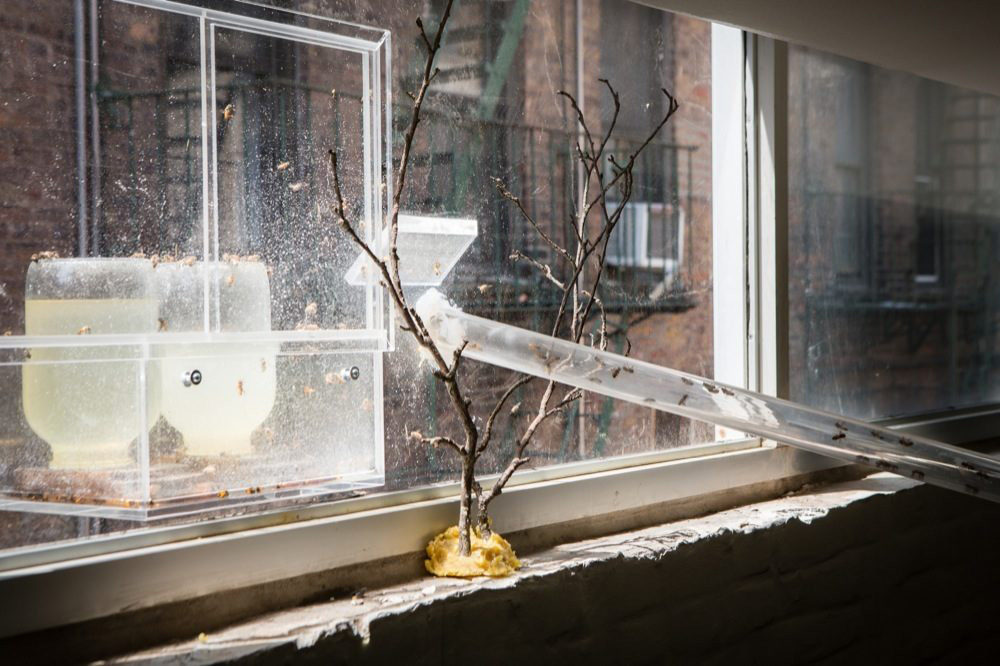
"terence koh: bee chapel," 2016. Installation image courtesy of the artist and Andrew Edlin Gallery. Photo: Olya Vysotskaya
MATT MULLEN: There’s all this talk about this being your “return” to the art world, even though—as you’ve pointed out in other interviews—you never really left, you just relocated.
TERENCE KOH: I don’t know what all the fuss is about. I just moved to the country. I used to understand because I used to be such a downtown artist—anything above Delancey Street was, like, Westchester. Maybe it makes good headlines. I just had a calling to go live in the mountains.
MULLEN: How does it feel to be back on the Bowery?
KOH: It feels great because I was looking for a home. We built the original bee chapel on my land, upstate—I live on a remote mountaintop—and I felt like this was something that I wanted to share with the world. When I heard that Andrew Edlin was moving to 212 Bowery, I was like, “Wow, 212 Bowery;” I knew this was such a significant address.
MULLEN: You used to live around here, right?
KOH: Yes, on Canal and Orchard. So it made sense. I just emailed him.
MULLEN: What was the genesis for the show?
KOH: First, there was the original bee chapel. I don’t know how it came about, but it came in a dream: You will build a bee chapel. It just came like that, and I was like, What’s a bee chapel? At that time I was working on these bee collages for the New York Art Book Fair. I did a stand there, by the way; so I didn’t retire, I was still at book fairs, sitting at a booth. [laughs] I was reading the Indian philosopher Jiddu Krishnamurti as well, and he was saying in times like these—he was writing in the ’60s, when there was the Vietnam War—change starts with one person at a time, and it starts with the spirit of that person first. Once you tend to the spirit, everything—technology, the environment, politics, society—will take care of itself. Then I thought, “Oh, wait, it makes perfect sense. A bee chapel is one person going in and resonating with a bee.”
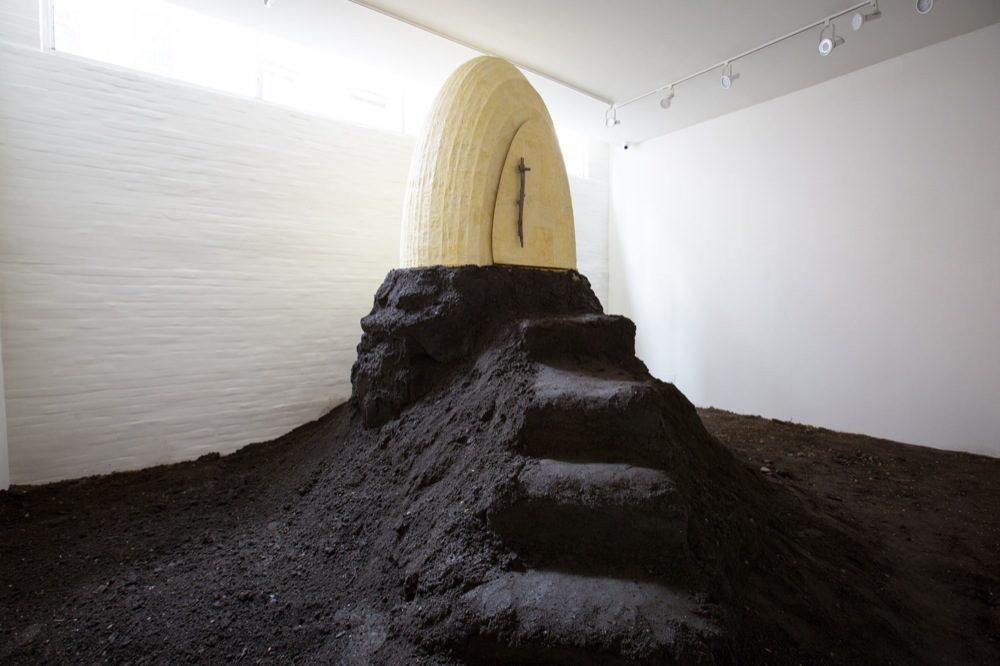
"terence koh: bee chapel," 2016. Installation image courtesy of the artist and Andrew Edlin Gallery. Photo: Olya Vysotskaya
MULLEN: Why bees?
KOH: Living in nature, you see bees, but you don’t see as many honeybees any more. You listen to the locals as well, and they go, “The honeybees are not appearing as much, they’re not having a good time.” It’s mostly our fault, because we’ve created these unnatural pollination cycles. I wanted to do something that brought back the natural cycle. So first it was the bee chapel on our land, and then we planted a ring of the two apple tress, and then we planted a ring of 14 apple trees, so we created a ring of 16 apples trees around the bee chapel. And then we planted every bee-friendly flower we could. So that attracted bumblebees, and honeybees, but also hummingbirds and butterflies in different seasons. Now we’ve brought it all here.
MULLEN: How has leaving Manhattan and moving upstate informed your process as an artist?
KOH: I don’t think about it that much; I don’t think I have a process. I just know, “bee chapel,” and then I go about figuring out what a bee chapel is. We went through many design configurations. At first I was so stupid that I thought it was going to be a pyramid covered in honey. And bees would naturally build their own home. But after speaking to a few beekeepers and architects, we devised this structure. It’s like the path that has no path. You just go along with it, and I guess that I’m lucky enough that I don’t have to have a job to make money; I work as an artist. I think it’s a big responsibility that I’ve been given, that I get to build bee chapels, and build campfires in the middle of galleries. This campfire thing, at first it was going to be a black candle hanging double sided in the middle of this gallery space. But I work on intuition, and it didn’t feel right. And then I just played around. It was an accident that the candle came down.
MULLEN: There’s a political edge to a lot of the work. What was your political mindset when creating these pieces?
KOH: I live on a mountaintop, but we have internet. [laughs] I’m Canadian, but everybody around me talks about politics; it’s a constant buzz. I’m more for Bernie myself, but I have no problems with Hillary. And Trump—I think this is an important thing—you have to see everybody as humans first, even him. That’s why you see Trump and Hillary and Bernie as babies; they were all innocent once. I don’t think the way to do it is to be negative, to go, “Oh, my god, Trump is this horrible person.” The way to go is, “He’s human, after all, and he maybe hurt or something.” He probably wants attention. Maybe he wasn’t given enough as a baby. Maybe that’s why the babies are there. But the way to do it is to give love. He’s a human being.
MULLEN: And hope he gives you love in return, maybe.
KOH: There’s a mysterious voice in the universe, that’s what I know living on a mountain. It sharpens your mind to things. I think it starts with love. As much of a hippy concept as that is, there isn’t enough of it, I think—of love and kindness and positive light.
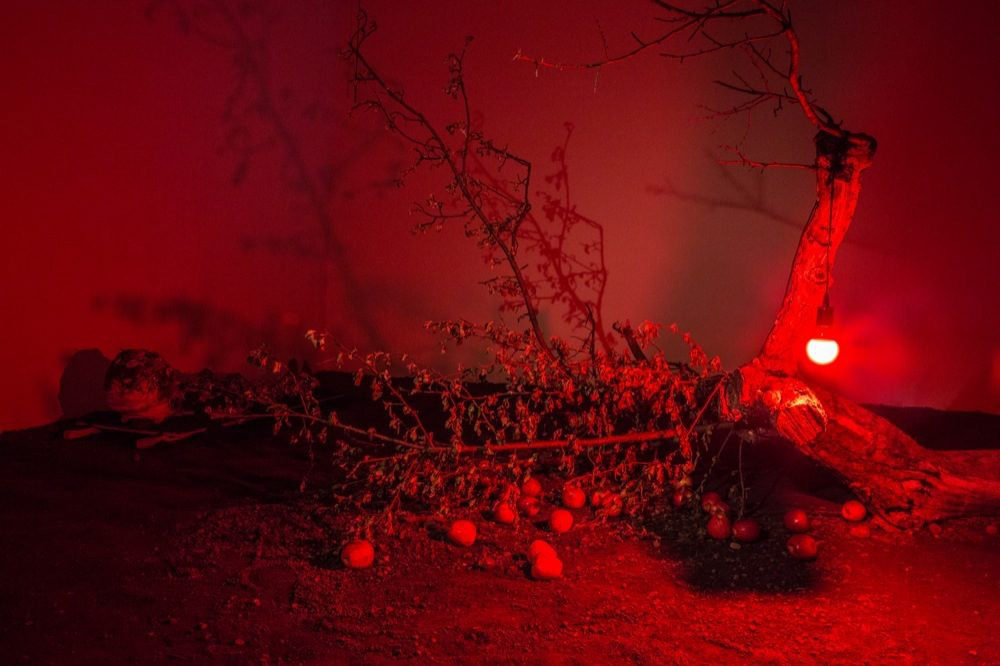
"terence koh: bee chapel," 2016. Installation image courtesy of the artist and Andrew Edlin Gallery. Photo: Olya Vysotskaya
MULLEN: That being said, how would you feel if Trump was elected?
KOH: I’ve thought about it, because it’s a strong possibility. I think it might be a motivating force for us. In my poster invite there’s a quote from Martin Luther King: “The angels of darkness are more persistent, they just go at it stronger than the angels of light.” I think about it in a way, because King was somebody who comes in the show a lot.
MULLEN: The show began with a procession, which also felt very political. Can you tell me about that?
KOH: I wanted to welcome the bees. There was a significance to where the march started, on 50 East First Street. There is a plaque outside it that says, “This is the home of the radical Justus Schwab.” All these radicals were meeting there 100 years ago, in a salon, doing the same thing, talking about how we can affect the world. That’s the reason that the procession had to start there.
MULLEN: Who else inspired you, and the show?
KOH: You know, someone a while ago mentioned Dash Snow. I didn’t even think about Dash—he was a good friend of mine—but then when I saw the show itself, I realized he was part of the mystery. And Paul Thek was another person who was a big influence, a spiritual figure. Maybe their spiritual energy came upstate or something, because Paul Thek was very political but he was also very spiritual as well. So was Dash. It wasn’t intentional, but I feel great about it because I know there is this invisible brotherhood and sisterhood of humans that flows throughout the universe. And maybe there’s a part of Dash or Paul that’s coming in. And if Paul or Dash are part of this show, I’m honored to be part of it.
MULLEN: Hearing about Dash makes me think of your old days. Can you talk more about retreating from public life, and entering into a more solitary one? Do you feel like your old self being back downtown?
KOH: I don’t feel like my old self; I don’t recall much of those days anymore. [laughs] I’m still the same person. These days, I see myself as the person behind the scenes, more like the Wizard of Oz. I’m not really public. I don’t even give interviews. I used to do many interviews and talk to people. But I thought this time that the message was more pertinent. I feel more aware of my mortality, I only have so many more years left.
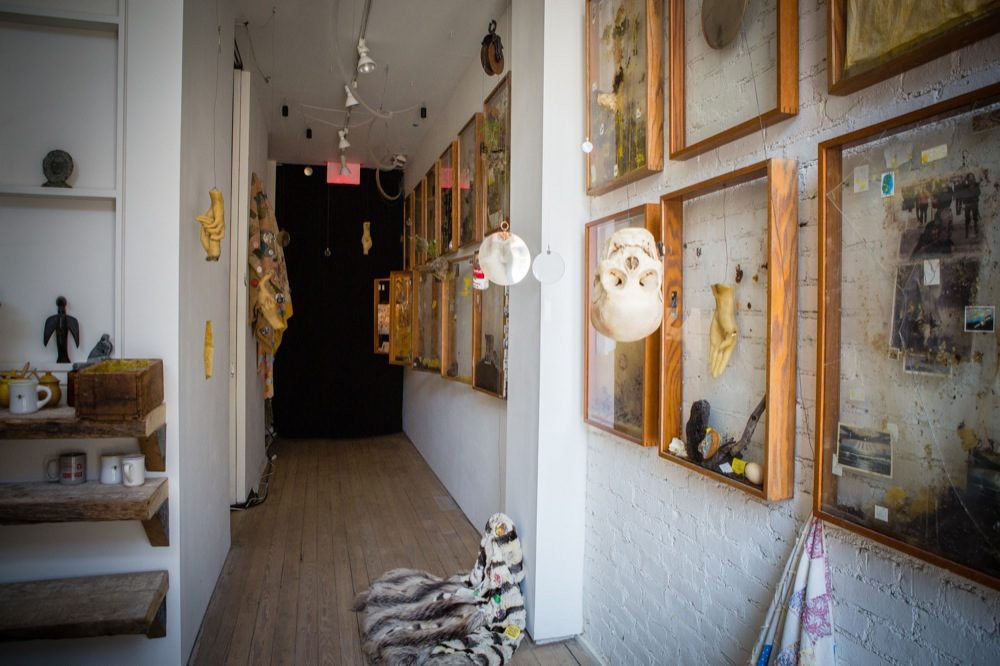
"terence koh: bee chapel," 2016. Installation image courtesy of the artist and Andrew Edlin Gallery. Photo: Olya Vysotskaya
MULLEN: How old are you?
KOH: No one knows except my mom and my boyfriend. A true lady doesn’t tell her age, so I’ll keep it secret for now. [laughs] But I feel that time is running out in my mortal life. But because I have this responsibility, I can do these things, like build bee chapels. It’s something that I always wanted to do but in a different way. I don’t feel like I have to perform anymore, or give interviews, or do press.
MULLEN: Is that nice?
KOH: It is actually, because when I was younger everything happened so fast for me, and you’re like a little kitten. But now, I’m up on the mountain and I just want to do my own thing. Garrick [Terence’s boyfriend] and I want to start a permaculture farm and become completely self-sufficient. But in a way it’s also something I want to leave to the world: it’s a utopia that’s completely self-sufficient. It’s nice to be back downtown, though, because I feel like this is a message that I wanted to share. Aliens might hear this, as well.
MULLEN: Is there anything you were afraid of in terms of this show?
KOH: I think it’s a genetic disposition, some people before shows, they get nervous. But it’s just something I’ve never been. I know it’s going to be written about and all these things, but it’s something that’s never bothered me. I’ve always been more interested in just doing the show as my thing. And there were so many big ifs in this show, like the bees. We actually went to heaven and hell to get to this point, because the gallery is not used to having 16 cubic yards of dirt in it. The bees could have also taken off very easily; they could have just gone, “We don’t like this home. Lets go back upstate!” We didn’t know if the candles were going to work, or if the apple tree was going to snap in half because it’s so fragile. But I don’t think I was afraid. No matter what happened the spirit was going to be there. Even if everything fell apart, the tree cracked in half, the bee chapel was empty, the spirit was there. [a bee buzzes] There’s a bee! So even if the mics didn’t work, the spirit was there. It makes you not afraid. Just like in politics: if Trump wins, it could be worse. It has been worse. We just have to let the light in.
MULLEN: So what’s next for you?
KOH: I’m going back upstate, right after this. I don’t have any plans, I don’t have any exhibitions. I don’t have any commitments. I’m just there to see what happens. It’s a mystery.
MULLEN: What does a normal day look like?
KOH: It’s busier than it looks, because we have to carry rocks to build mounds for the gardens. Now it’s planting season. It’s so crazy that I’m speaking about this, because just two years ago I was dressed in all white and everything was perfect. But now I’m thinking about the thunderstorms: we have to plant the remaining seeds so they all get watered. Every day’s an adventure.
“TERENCE KOH: BEE CHAPEL” WILL BE ON VIEW AT ANDREW EDLIN GALLERY UNTIL JULY 1, 2016.

